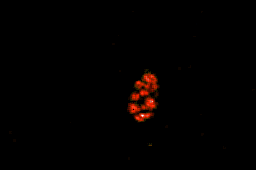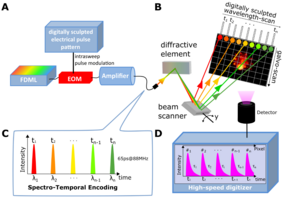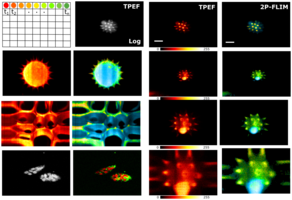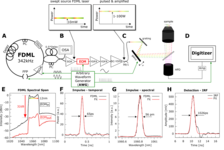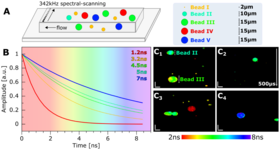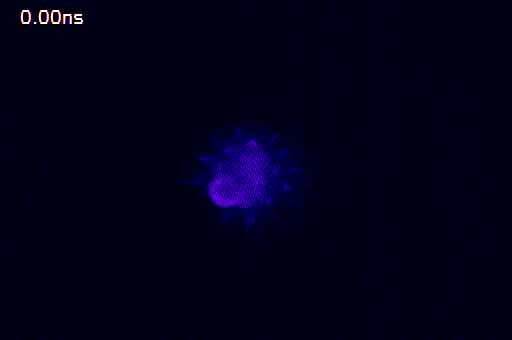Research of novel laser light sources
The AG Karpf conducts research on the development of novel laser light sources and their use in biomedical imaging. The recently developed SLIDE microscope enables rapid imaging in nonlinear two-photon microscopy, where frame rates of 2kHz and more are achieved. Such fast acquisition speeds coupled with the molecular specificity of fluorescence markers and the high optical resolution in the sub-µm range allow the observation of fastest biological processes down to the interior of a cell. One application that will be pursued in the future with the SLIDE microscope at the University of Lübeck is imaging flow cytometry, in which hundreds of thousands of cells are imaged and multi-modally examined within a very short time to diagnose extremely rare cells, such as circulating tumor cells, among a large number of healthy cells.
SLIDE Mikroscopy
The SLIDE microscope was developed by Sebastian 'Nino' Karpf at UCLA, California to visualize rapid biological processes using nonlinear two-photon microscopy. Modern two-photon microscopes use galvanometric scanning mirrors that achieve line speeds of approximately 20,000 lines per second. These speeds are inertia-limited of the moving mirrors and therefore cannot be increased arbitrarily. If one wants to achieve faster scanning speeds, one has to use inertia-free scanning methods. The SLIDE microscope achieves orders of magnitude higher line scan speeds by using a fast wavelength tuneable laser and deflecting it by means of a diffraction grating. This achieves inertia-free scanning speeds of MHz and more. A further advantage is the fast data acquisition, which also enables transient fluorescence decay curves to be recorded and information from the molecular environment of the fluorescent dyes to be extracted using FLIM imaging. This multi-modality is extracted from the same measurement data, which is why both physical information channels - TPEF and FLIM - are recorded with the same fast frame rate of 2kHz and more.
This visualization illustrates well the phenomenon of the fluorescence lifetime, since at time 0ns the excitation light pulse is sent onto the sample and in the following time different parts of the pollen start to fluoresce and emit light at different durations afterwards. The bulge at the bottom left has the longest fluorescence lifetime. The fluorescence lifetime was measured by SLIDE microscopy with fast data acquisition of 6.25 GSamples/s, a pixel rate of 176 MHz and an image acquisition speed of 1ms per image. The video shown here was averaged from 100 images, resulting in a total acquisition time of 100ms.
If you are interested in contributing to this new field of research, please send us an e-Mail. We are always looking for motivated bachelor and master students who are curious and interested in biomedical research and would like to participate in the development of this new technology. Here you can find current topics.
Groupleader
Sebastian 'Nino' Karpf

Gebäude 81
,
Raum 71
sebastian.karpf(at)uni-luebeck.de
+49 0451 3101 3240
PhD Students
Tonio Kutscher

AG Karpf
Gebäude Gartenhaus 58.600
,
Raum 11
t.kutscher(at)uni-luebeck.de
+49 451 3101 3291
Florian Sommer

AG Karpf
florian.sommer(at)student.uni-luebeck
+49 451 3101 3217
Christian Stock

AG Karpf
Gebäude Gartenhaus 58.600
,
Raum 11
ch.stock(at)uni-luebeck.de
+49 451 3101 3292
Stefan Reinhards

AG Karpf
Gebäude Gartenhaus 58.600
,
Raum 10
stefan.reinhards(at)uni-luebeck.de
+49 451 3101 3217
Matthea Thielking

AG Karpf
Gebäude Gartenhaus 58.600
,
Raum 10
m.thielking(at)uni-luebeck.de
+49 451 3101 3218
Gregory Berg

AG Karpf
Gebäude Gartenhaus 58.600
,
Raum 8
g.berg(at)uni-luebeck.de
+49 451 3101 3215

